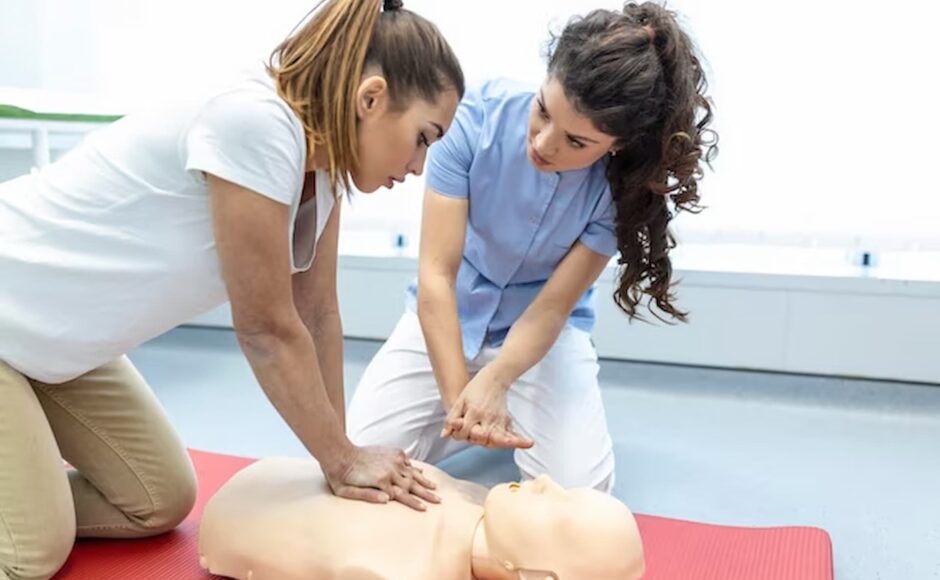Choking incidents can happen unexpectedly and swiftly, turning a mundane moment into a potentially life-threatening situation. This comprehensive guide delves into the essential steps of effective choking first aid, equipping you with the knowledge to act swiftly and decisively in critical moments.
Recognising The Signs
The first step to effective choking first aid is recognising the signs of a person in distress. A choking individual may clutch their throat, be unable to speak or exhibit a panicked expression. It is crucial to stay alert to these signals, as a prompt response is paramount. Additionally, keep an eye out for subtle cues like a change in skin colour, indicating oxygen deprivation.
Maintaining Calmness In Crisis
In the chaos of an emergency, maintaining composure is challenging but indispensable. Panic can hinder your ability to think clearly and act decisively. Take a deep breath, assess the situation, and remember the importance of your role in providing assistance. Keeping a level head benefits the victim and facilitates a smoother execution of life-saving techniques.
Performing The Heimlich Maneuver
The Heimlich maneuver, a widely recognised technique, is a cornerstone of choking first aid. To execute it effectively, stand behind the person, wrap your arms around their waist, make a fist, and place the thumb side against the middle of their abdomen above the navel. Deliver quick, upward thrusts until the object causing the obstruction is expelled. It’s worth noting that the force applied should be vigorous yet controlled, preventing unnecessary harm.
Calling For Professional Help
While immediate action is crucial, it is equally important to call for professional help. In the age of advanced emergency services, dialling emergency services should become a reflex. Communicate the situation clearly and follow any instructions provided by the dispatcher. Remember that while you provide initial aid, professional assistance is essential for a thorough evaluation and any necessary follow-up care.
Adapting Techniques For Different Ages
Choking incidents can affect individuals of all ages, from infants to the elderly. It is imperative to adapt your approach based on the age group. For infants, the Heimlich maneuver involves delivering back blows while supporting the baby’s head. With older children and adults, the traditional Heimlich maneuver is more appropriate. Understanding these age-specific nuances enhances your preparedness and effectiveness in diverse scenarios.
Utilising The Heimlich Maneuver Alternatives
In situations where the Heimlich maneuver is not suitable, alternative techniques come into play. For instance, if the person is pregnant or obese, chest thrusts may be more effective. Understanding these alternatives broadens your ability to provide aid in diverse circumstances. However, always prioritise professional help, especially if the situation is complex or if your initial attempts are unsuccessful.
Remaining Prepared With First Aid Training
Knowledge is the key to effective choking first aid. Enrolling in first aid training courses ensures you are equipped with the skills and confidence needed in emergencies. These courses cover a range of scenarios, enabling you to respond effectively to various medical situations. Regularly refreshing this training ensures that your skills remain sharp and you stay updated on the latest techniques and guidelines.
Creating A Safe Environment
Prevention is as crucial as intervention. Creating a safe environment involves being mindful of potential choking hazards. Regularly inspecting living and working spaces for small objects, loose parts, or food items that pose a choking risk can significantly reduce the likelihood of an incident. Taking proactive measures to eliminate hazards showcases a commitment to safety that extends beyond responding to emergencies.
In conclusion, mastering the art of choking first aid is not just an individual responsibility but a collective one. By disseminating knowledge on effective techniques and fostering a culture of preparedness, communities can become safer and more resilient in the face of emergencies. Remember, the key lies in swift action, maintaining composure, and adapting techniques to diverse situations. Your preparedness could be the crucial difference between a moment of crisis and a life saved.




